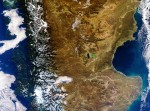Friday, July 29th, 2011
The orbit of ESA’s retired ERS-2 observation satellite is being lowered to reduce the risk of collision with other satellites or space debris. The goal is to leave it well below most operating polar satellites by the end of August. The first in a series of thruster firings, each lasting about 300 seconds, was commanded by
Saturday, July 23rd, 2011
Drought in Somalia, Kenya, Ethiopia and Djibouti is pushing tens of thousands of people from their homes as millions face food insecurity in a crisis visible from space. ESA’s SMOS satellite shows that the region’s soil is too dry to grow crops. Read More

Friday, July 22nd, 2011
This Envisat image is dominated by southern Argentina, with the mountainous terrain of the Andes in Chile to the west (left). The lush, snow-capped mountains slope into the arid inland areas of Argentina’s Chubut province and neighbouring Santa Cruz province to its south – home to a series of plateaus and depressions.
Wednesday, July 20th, 2011
Oceans cover much of our planet and they are difficult to keep under surveillance, with the trafficking of people, unlicensed fishing and piracy adding to the problem. Satellites, however, can help keep the seas safe. Satellites monitor the entire planet and are an obvious component of an improved surveillance system. Satellite imagery can be used to
Friday, July 15th, 2011
Satellites can bring new transparency to how forests are being managed. With the increasing production of pulp, paper and timber products, there is concern over the effect that expanding plantations and logging in natural forests have on biodiversity and climate change. At the recent general assembly of the Forest Stewardship Council (FSC) in Kota Kinabalu,
Sunday, July 10th, 2011
Some of the last images from ESA’s ERS-2 satellite have revealed rapidly changing glacial features in Greenland. In its final days, the veteran satellite gave us frequent views of the Kangerdlugssuaq glacier and its advancing ice stream. Before it retired on 6 July, ESA’s ERS-2 Earth observation satellite entered an orbit to capture radar images of
Thursday, June 30th, 2011
In Norway, avalanches pose a risk to road users every year. Since much of the country is remote, knowing exactly where avalanches have blocked roads is a challenge for the authorities. However, ESA has recently shown that satellites could help. The Norwegian Public Roads Administration (NPRA) is responsible for the national road network. In the winter,
Thursday, June 23rd, 2011
The two Soyuz launchers that will fly the first four satellites of Europe’s Galileo navigation system into orbit have arrived at Kourou harbour in French Guiana, completing a journey that took them halfway round the world. The first two Galileo In Orbit Validation satellites are set to be launched from Europe’s Spaceport on 20 October, with
Wednesday, June 22nd, 2011
As Europe prepares for October’s launch of the first Galileo satellites, a worldwide ground network is being put in place. Contracts signed today at the Paris Air & Space Show cover satellite control and the systems needed to generate Galileo services. Read More
Tuesday, June 21st, 2011
The first map of sea-ice thickness from ESA’s CryoSat mission was revealed today at the Paris Air and Space Show. This new information is set to change our understanding of the complex relationship between ice and climate. From an altitude of just over 700 km and reaching unprecedented latitudes of 88º, CryoSat has spent the